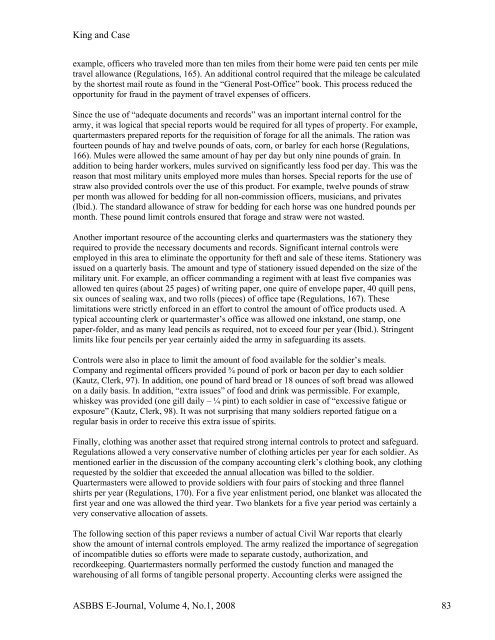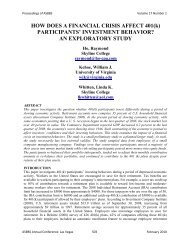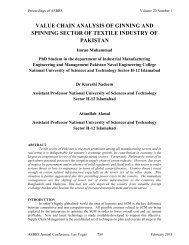stock repurchase announcements: a test of market ... - Asbbs.org
stock repurchase announcements: a test of market ... - Asbbs.org
stock repurchase announcements: a test of market ... - Asbbs.org
Create successful ePaper yourself
Turn your PDF publications into a flip-book with our unique Google optimized e-Paper software.
King and Case<br />
example, <strong>of</strong>ficers who traveled more than ten miles from their home were paid ten cents per mile<br />
travel allowance (Regulations, 165). An additional control required that the mileage be calculated<br />
by the shor<strong>test</strong> mail route as found in the “General Post-Office” book. This process reduced the<br />
opportunity for fraud in the payment <strong>of</strong> travel expenses <strong>of</strong> <strong>of</strong>ficers.<br />
Since the use <strong>of</strong> “adequate documents and records” was an important internal control for the<br />
army, it was logical that special reports would be required for all types <strong>of</strong> property. For example,<br />
quartermasters prepared reports for the requisition <strong>of</strong> forage for all the animals. The ration was<br />
fourteen pounds <strong>of</strong> hay and twelve pounds <strong>of</strong> oats, corn, or barley for each horse (Regulations,<br />
166). Mules were allowed the same amount <strong>of</strong> hay per day but only nine pounds <strong>of</strong> grain. In<br />
addition to being harder workers, mules survived on significantly less food per day. This was the<br />
reason that most military units employed more mules than horses. Special reports for the use <strong>of</strong><br />
straw also provided controls over the use <strong>of</strong> this product. For example, twelve pounds <strong>of</strong> straw<br />
per month was allowed for bedding for all non-commission <strong>of</strong>ficers, musicians, and privates<br />
(Ibid.). The standard allowance <strong>of</strong> straw for bedding for each horse was one hundred pounds per<br />
month. These pound limit controls ensured that forage and straw were not wasted.<br />
Another important resource <strong>of</strong> the accounting clerks and quartermasters was the stationery they<br />
required to provide the necessary documents and records. Significant internal controls were<br />
employed in this area to eliminate the opportunity for theft and sale <strong>of</strong> these items. Stationery was<br />
issued on a quarterly basis. The amount and type <strong>of</strong> stationery issued depended on the size <strong>of</strong> the<br />
military unit. For example, an <strong>of</strong>ficer commanding a regiment with at least five companies was<br />
allowed ten quires (about 25 pages) <strong>of</strong> writing paper, one quire <strong>of</strong> envelope paper, 40 quill pens,<br />
six ounces <strong>of</strong> sealing wax, and two rolls (pieces) <strong>of</strong> <strong>of</strong>fice tape (Regulations, 167). These<br />
limitations were strictly enforced in an effort to control the amount <strong>of</strong> <strong>of</strong>fice products used. A<br />
typical accounting clerk or quartermaster’s <strong>of</strong>fice was allowed one inkstand, one stamp, one<br />
paper-folder, and as many lead pencils as required, not to exceed four per year (Ibid.). Stringent<br />
limits like four pencils per year certainly aided the army in safeguarding its assets.<br />
Controls were also in place to limit the amount <strong>of</strong> food available for the soldier’s meals.<br />
Company and regimental <strong>of</strong>ficers provided ¾ pound <strong>of</strong> pork or bacon per day to each soldier<br />
(Kautz, Clerk, 97). In addition, one pound <strong>of</strong> hard bread or 18 ounces <strong>of</strong> s<strong>of</strong>t bread was allowed<br />
on a daily basis. In addition, “extra issues” <strong>of</strong> food and drink was permissible. For example,<br />
whiskey was provided (one gill daily – ¼ pint) to each soldier in case <strong>of</strong> “excessive fatigue or<br />
exposure” (Kautz, Clerk, 98). It was not surprising that many soldiers reported fatigue on a<br />
regular basis in order to receive this extra issue <strong>of</strong> spirits.<br />
Finally, clothing was another asset that required strong internal controls to protect and safeguard.<br />
Regulations allowed a very conservative number <strong>of</strong> clothing articles per year for each soldier. As<br />
mentioned earlier in the discussion <strong>of</strong> the company accounting clerk’s clothing book, any clothing<br />
requested by the soldier that exceeded the annual allocation was billed to the soldier.<br />
Quartermasters were allowed to provide soldiers with four pairs <strong>of</strong> <strong>stock</strong>ing and three flannel<br />
shirts per year (Regulations, 170). For a five year enlistment period, one blanket was allocated the<br />
first year and one was allowed the third year. Two blankets for a five year period was certainly a<br />
very conservative allocation <strong>of</strong> assets.<br />
The following section <strong>of</strong> this paper reviews a number <strong>of</strong> actual Civil War reports that clearly<br />
show the amount <strong>of</strong> internal controls employed. The army realized the importance <strong>of</strong> segregation<br />
<strong>of</strong> incompatible duties so efforts were made to separate custody, authorization, and<br />
recordkeeping. Quartermasters normally performed the custody function and managed the<br />
warehousing <strong>of</strong> all forms <strong>of</strong> tangible personal property. Accounting clerks were assigned the<br />
ASBBS E-Journal, Volume 4, No.1, 2008 83

















